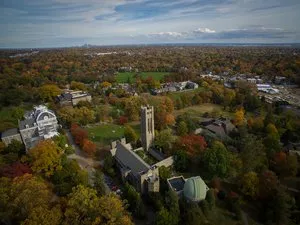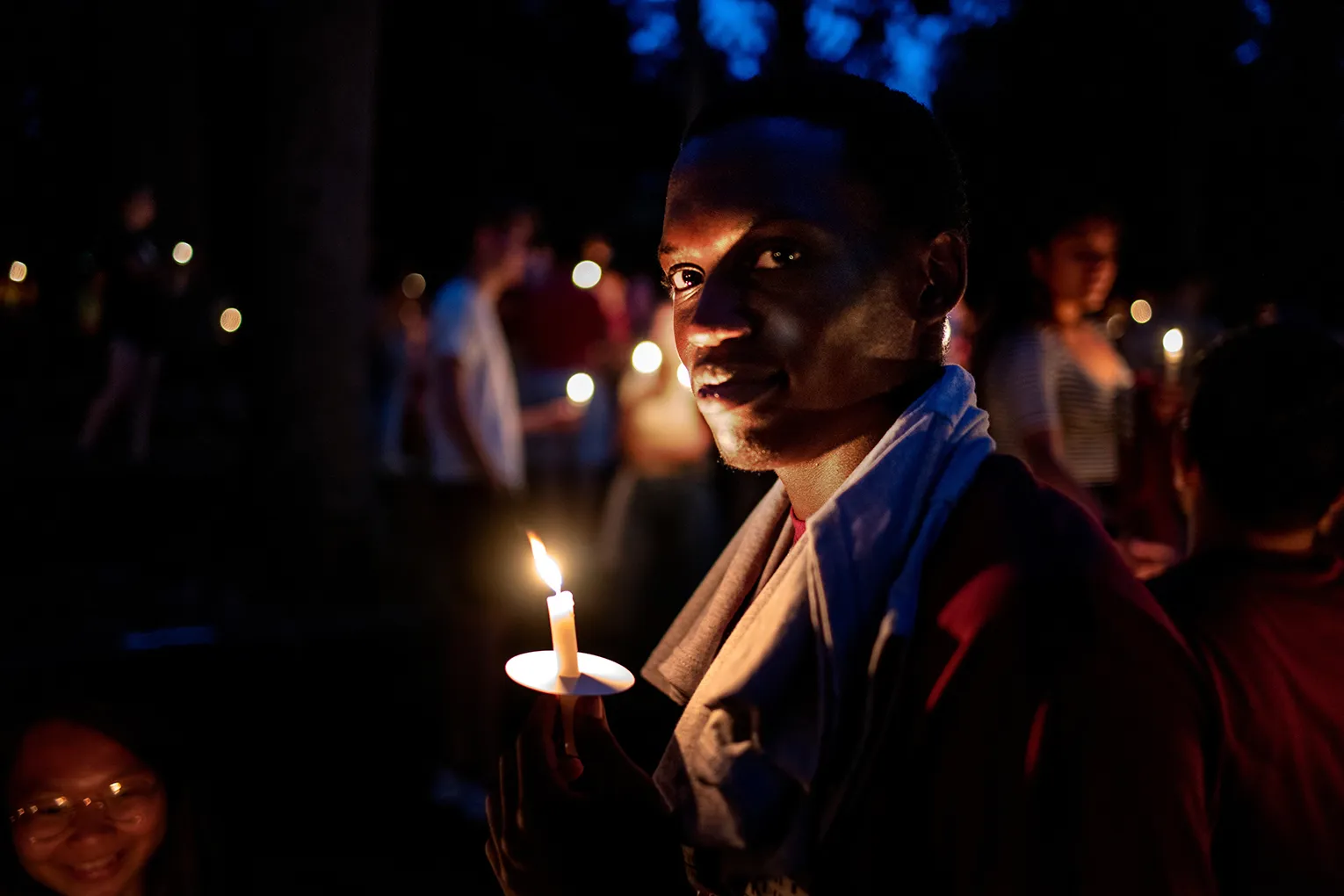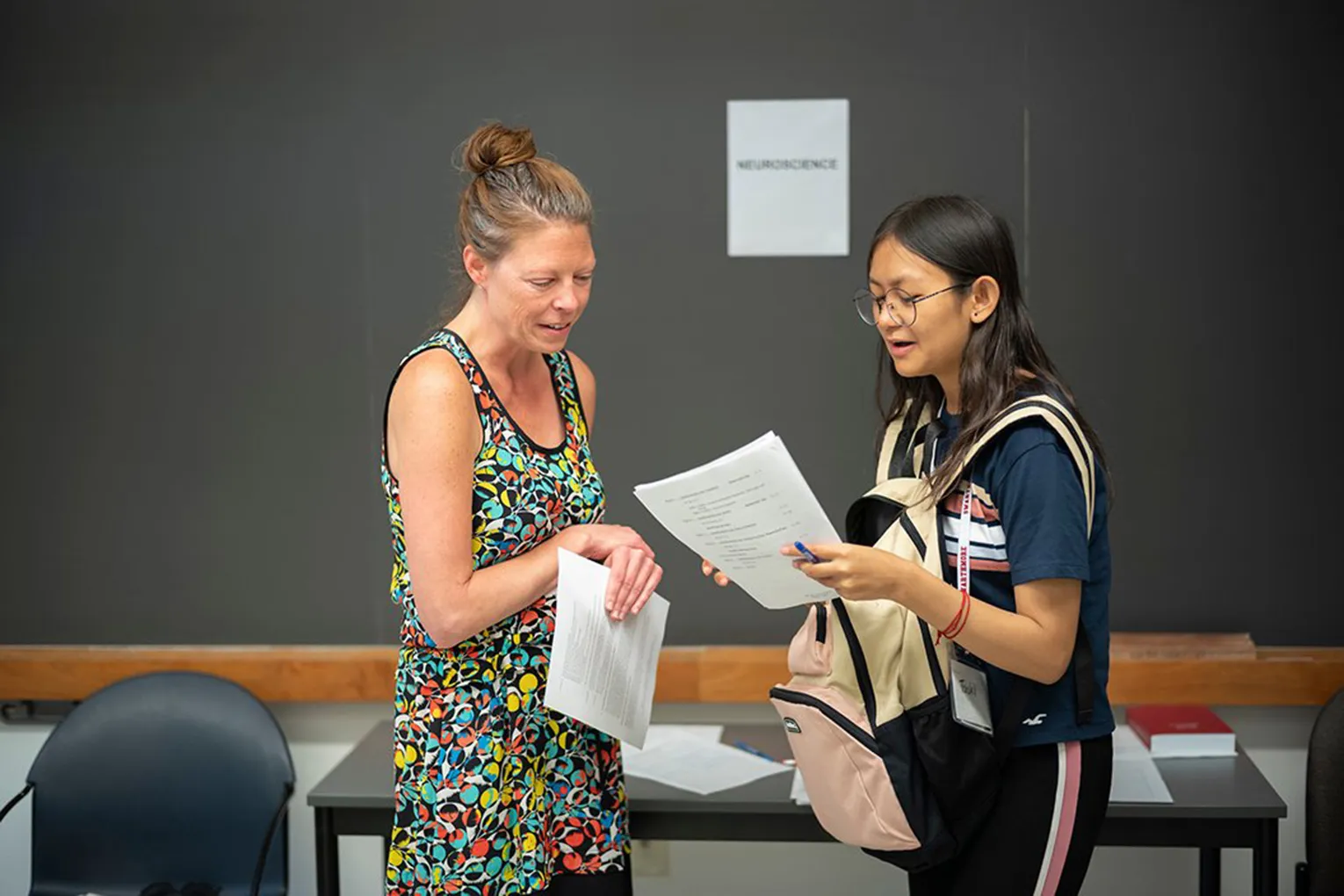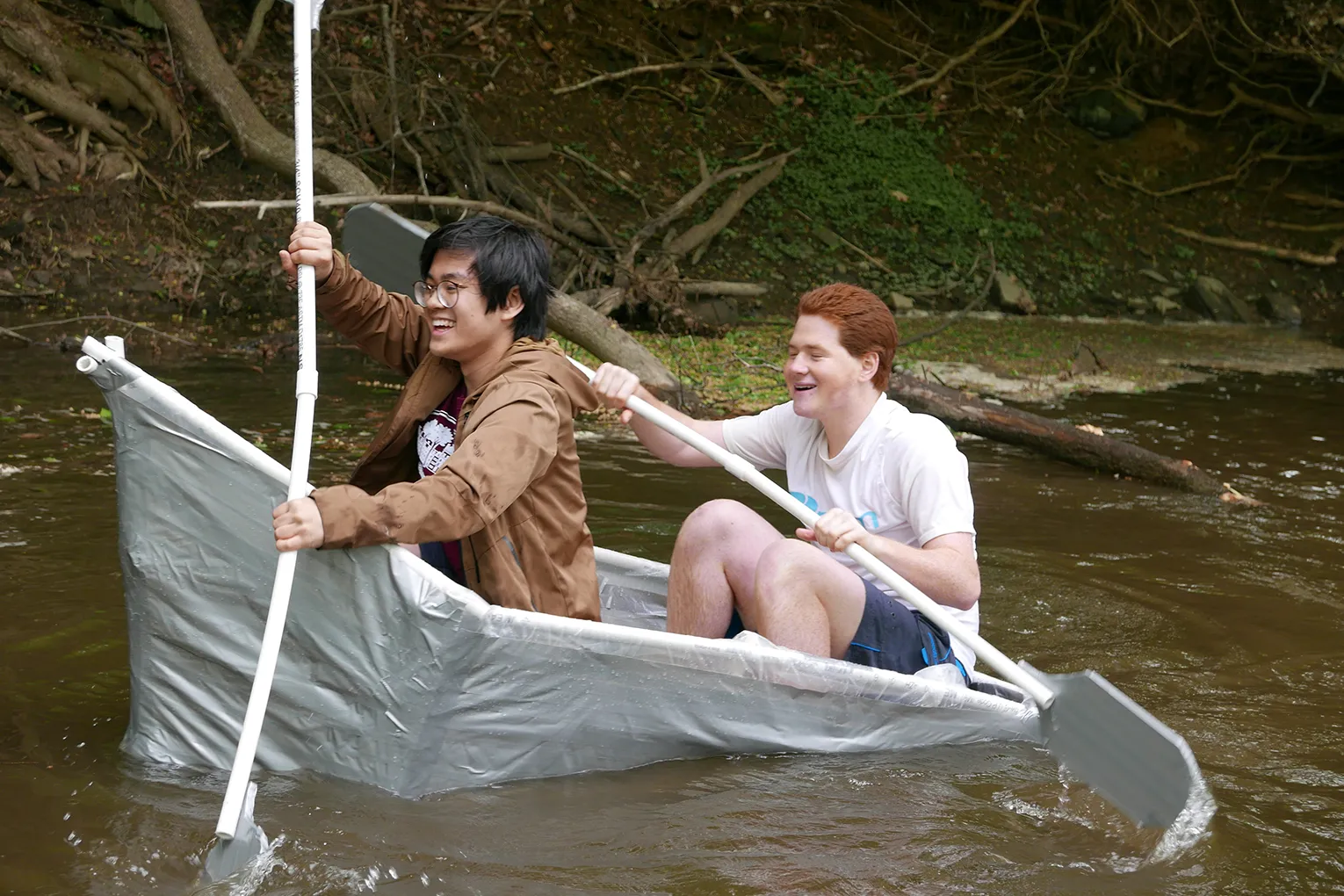President Smith, distinguished guests and honorees, parents, and students of the Class of 2025.
As this is my last official role as a Swarthmore College faculty, I am very honored to speak here tonight to all of you. Thank you for inviting me to close this chapter of my career and witness the opening of our students. As I move into retirement, and what lies beyond professor and scholar and teacher, I will, like all of you, be engaging in a shift into something else, perhaps another career, a new job, a different status. We call this rite of passage. For you, students of the Class of 2025, graduation is a building up to a transformation, as all of you will undergo, filled with speeches, magical words, blessings and exhortations, music and song, costumes and robes and funny flat hats, as you walk across that stage and to the other side, you will become someone else, not what you were just seconds before. You will be transformed. You will receive your very hard earned and well deserved degrees, and become a graduate of Swarthmore College. And for now, in this time out of time, where we are, I would like for all of us to feel the specialness of this moment. Not with a prayer, but with the gift and the blessing of each other's presence.
So just for a second, let us try something, let us breathe in and ground ourselves in this time and place with presence. Take a breath. Students, I want you to feel what you have created together over the years. With your peers, classmates, your beloveds, your mentors, and friends. Recall the joys and the struggles that brought you to this place. Present.
This is a ritual. We, from where we stand as your teachers, observe you come and then you leave, and go out into the world. We watch you start new lives. If we are fortunate enough, as I have been, we even see some of your children return to this place as students. Another breath.
We walked this road together, but you will never experience this exactly in the same way. As you move through this ritual, may you be free to be who you truly are, free from whatever holds you back. May you have joy, may you have gratitude.
I want us to consider the rite of passage as something we like to talk a lot about in Religious Studies. As some of you know, the rites of passage come from the work of a scholar of East African religion, the British cultural anthropologist Victor Turner, who did much of his fieldwork in the realm of indigenous African traditions and practices, as many anthropologists and religionists did at one time or another, prior to the postmodern and postcolonial reckoning with such academic habits. Turner and his wife Edith were not ordinary western scholars entering into the primitive field to reap insights from the native people, but they were deeply enmeshed in the cultures, the languages, and the lifeworlds of their subjects. Turner learned that every rite of passage has a “threshold” or a doorway into the passage. What we call a liminal zone. It is neither before nor after, it is the essence of liminality. Where one is separating from the previous state and entering into something else. For the human being, it is where identities hang in the balance. Think about it. That’s exactly where you are right now.
Turner said that the liminal phase was constituted as something very interesting. He called it "betwixt and between." Liminality, he found, is ambiguous. It is limbo. It is time out of time. You don’t belong to Swarthmore College anymore, but for now you do. You are not yet reincorporated into what comes next. So you are becoming free, in a sense. You, with your friends and classmates, are in communitas. Intense social togetherness. Belonging, even if you don’t belong with everyone else. This might apply specifically to the community of the Honors students.
Communitas is in fact characterized by tests and ordeals, psychic and physical ambiguity, but also the breaking down of cultural norms and rigid social hierarchies. It is a place of unity, and solidarity, but also instability; it can be chaotic, like cleaning out your room. It
can be festive and carnivalesque like senior week; it is an experience of time and space collapsing, but also it is the heady anticipation of freedom. I know many of you feel this way right. This joy, fear, apprehension, and knowing that something special is about to happen — and all that will end.
I have taught in a religion department that equips students to enter the world, but the most important lessons have been those which they have given to me. We love and protect each other, even when we don’t like how the other thinks. This is the true meaning of respect. This is the meaning and value of the arts and the humanities for nurturing critical, compassionate thought; cultivated ethical reasoning; and practiced the art of truly listening, striving always toward deeper understanding. These are not just academic skills but essential capacities for navigating our diverse and interconnected world, where all too often we feel separate, alienated, and alone from the family that we are all a part of.
And yet, even with the most extraordinary colleagues and friends in the department, I’ve been aware that much of this campus still wonders what it is exactly that we do over in that place on the other side of campus — at the edge, near our historic late-19th-century Friends Meeting House. Many of our students have never taken a course in comparative religion.
Today, the study of religion — rooted in the arts and humanities — finds itself under political and cultural scrutiny. These critiques reflect a deeper skepticism: that the arts and humanities no longer offer a valuable — or valued — educational experience.
Critics sometimes argue that liberal arts programs — including Religious Studies — advance partisan agendas. This perception has fueled skepticism about both the objectivity and the value of disciplines like ours, and of the liberal arts project in general.
Colleges, for example, have been accused of indoctrination, and faculty have faced public pressure and personal attack. Some have been targeted, including here at Swarthmore. Organizations have launched professor watchlists. These campaigns are not debate; they are acts of intimidation that are meant to silence voices in our community.
Some of us have found ourselves caught in the crossfire of skepticism and culture-war anxieties. On one side is the argument that we have failed to redress structural inequities, failed to live up to our commitment to represent the most marginalized voices, and neglected to decolonize our curricula or ground our theoretical and historical perspectives in social justice.
Others, in disagreement, have claimed that diversity and inclusion efforts within universities come at the expense of traditional values and majority perspectives. These concerns have created tensions between contemporary diversity initiatives and certain priorities within higher education.
What’s more, a 2019 Pew study found that a majority of Americans now believe colleges have a negative effect on the populations they are meant to serve — not only because of rising costs, but because of a belief that students are being intellectually indoctrinated. Religion, my field, along with other humanities disciplines, is caught in the shadow of those beliefs.
These discussions have touched everything from curriculum to campus protest, and they’ve sparked intense debate about academic freedom and the limits of higher education.
Supporters frame the need for action as necessary corrections. Critics see them as ideologically driven overreach and political interference within private communities. Either way, they raise urgent questions: Who decides what gets taught? Who gets to speak? Are all voices equal?
Of course I don’t have answers to a lot of this but I can say this and to underline the point that others have made and continue to make: Collaborative teaching and learning can foster mutual respect and intellectual courage. That courage will now be asked of you. As graduates, your responsibility will be to ask hard questions, to remain vigilant, and to speak with care and clarity in a world increasingly suspicious of complexity.
If the arts and humanities didn’t matter, no one would fight over them. And in fact I would argue that the very controversy proves the value. These fields raise questions about meaning, authority, belonging, and the stakes of civic life. When some would try to control what can be taught, it’s a reminder that our disciplines are not ornamental. They are essential.
At the heart of this I think is a struggle over ideas in the classroom. But these are the very topics that students at Swarthmore, and in my classroom at least, have enjoyed wrestling with together, for over 30 years.
I want to share how this place has blessed me with over the years, specifically in our Religion classroom and apart from it. Every one of these experiences creates sacred space, every one of these allows for the cultivation of gratitude, the healing medicine for cynicism, and the nihilism of separation and distrust. So I would argue that the study of religion, culture, and history teaches us to question received truths, not to dissuade us from our innermost spiritual longings or our belief, but to deepen it.
Now let me show you what this looks like — with a personal travelogue. Let me talk about what we have created over the years together in the spirit of exploration, joy, and mutual collaboration. For the past 30 years, I have taught courses about religion and about religions. From the start, a web of trust and curiosity binds us together to enjoy the blessings of the shared intellectual project — what Professor Cornel West has called the cultivation of the life of the mind. We feel our way into this through Food and Religion, my favorite course in all my years at the College.
In my Food and Religion class, first-year students came together for an experiment — not only to eat, but to experience what we have in common by working through this thing that we believe we understand as religion. Students come from the far reaches of the globe, from different backgrounds, spiritual affiliations, different skills and abilities, Some of my students were scientists, some were atheists, some were Buddhists, some were Freethinkers, wiccans, evangelicals, Hoodoo practitioners, and Muslims. We read entire books that theorized religion. We made cookies and crackers in the original style by the 19th century Protestant health reformer Sylvester Graham. We crafted sweet sticky pyramids of Sephardic Charoset for passover. We gobbled down tasty bean pies from the sisters at the Nation of Islam, and we reverently offered our gifts of Pan de Muerto at the altars and installations on campus for the Day of the Dead and All Souls’ Day in late October.
In the course on Magic and Religion, we experienced folk healing from visiting practitioners of Pennsylvania German Dutch pow-wow traditions. We learned about Jewish magic from Doctor Weiss from the Temple of Miriam. Some students made sigils and good luck charms in time for finals. We argued over science, miracles, and efficacy.
In our Film and Religion course, students explored sacred depictions in 20th-century cinema. We examined courage, community, violence, and faith across cultures on film.
This was not a course in criticism, but to teach writing from within the discipline and how to engage religion academically, as a global and visual phenomenon.
Speaking of films, some of you saw the Ryan Coogler film Sinners and you might know that I had a small hand in that, but you probably don’t know that a Swarthmore religion student was one of the consultants for the Fortnite crossover tie-in for the film by Warner Brothers. There are many wonderful things that one can do with what we learn here.
Many of our best classroom and teaching experiences went beyond the bounds of the classroom. Our campus is an arboretum, it is also the grounds of the Lenape people, who were the original stewards of this land. Our class learned of the sacredness of plants and reciprocality of spirit and the bounty of the earth from the Native American traditions. We wandered the campus in search of these gifts, pawpaws over by Willets and fig trees at the Lodges, but someone had always picked them clean.
Swarthmore religion students have attended LDS temple services, danced at Haitian Vodou ceremonies, and explored Quaker stories. Quakers have a rather distinctive living history in this area, as Swarthmore sits as one of the stations of the Underground Railroad, and that the Friends themselves were the earliest and some of the most radical and progressive antislavery advocates of any Christian religious denomination in early America. And of course, you all know that from its founding, Swarthmore admitted men and women on equal terms — a radical move at a time when most U.S. colleges were all-male. The commitment to gender equality remains a hallmark of the Quaker heritage today.
One of the most profound and meaningful experiences for me occurred years ago, when Professor Sa’ed Atshan — a teacher and scholar at this College who inhabits the Quaker spiritual values he professes in thought, word, and deed — offered a once-in-a-lifetime opportunity to join a teaching and learning tour through Israel and the West Bank-Palestine, the first off-campus trip of its kind to be undertaken by Swarthmore College. Our students — a vivid mix of backgrounds, faiths, and cultures — rose to the occasion in one of the most complex and difficult zones of conflict, with generosity and curiosity throughout, with friendship, and with mutual support of each other. It was a remarkable group, one that embodied Swarthmore’s core commitments: Intellectual curiosity, a commitment to truth, and the courage to engage difficult and often painful questions with empathy and understanding. You do this so well.
But singularly, the thing I have loved most to teach — and to learn — has been the long, quiet journey into the spiritual world of African Americans: the unseen architecture of their survival, the faith forged in bondage, the wisdom carried across generations to make sense of a sojourn in a land that was not meant to be home, yet became one.
I think of two brothers — James Weldon Johnson and John Rosamond Johnson — sons of the South, sons of the struggle, two artists and humanists. The Johnsons believed that the elevation of a people lay not only in politics or protest, but in the power of the mind, in the refinement of the spirit. They were organic intellectuals who believed that beauty was essential to freedom. I have urged students to also carry these ideas.
One wrote the words, the other composed the music, for what would become the sacred hymn of a people:
Stony the road we trod,
Bitter the chastening rod,
Felt in the days when hope unborn had died;
Yet with a steady beat,
Have not our weary feet
Come to the place for which our fathers sighed?
The study of African American and Africana religions has been the work of my life. This sacred culture is not peripheral to the American story. It is foundational to it. For in this story — this unbroken chain of endurance, ritual, loss, and transcendence — we begin to glimpse the common cords that bind us together. This is a history written not just in archives, but in blood, in tears, in the whispered prayers of those who have come before us, the ancestors.
And here, in this very region, lies a beacon of that inheritance. Philadelphia — the birthplace of the AME Church, the first Black Christian denomination in the United States. A church that, in the late 18th century, led the earliest civil rights walkout in American history, in a moment of sacred resistance. It is a space that I have taken students to visit since I began teaching my very first course here.
There has been, for me, always, always time for me to enjoy the things that students shared with me outside of the academic study. Things we no longer do, like the Dash for Cash for the co-ed rugby teams, the tradition of running from the top of Parrish Hall, naked as the day they were born save for glitter and several deep bucket cowboy hats. I now understand the joys of Doc Martens, and triple deluxe chocolate chip decadence from Insomnia. I appreciate all the plays and performances students have invited me to, basketball and lacrosse competitions, even when you left class early.
So I want to finish by thinking about blessings. I want to extend a blessing to you, and for you to bless each other, but most importantly I want you to recognize this is the liminal phase, Class of 2025, you stand in that luminous threshold Turner described. May you carry forward both the humility of the Quaker spirit we honor at Swarthmore and the wonder of every rite of passage you have and will ever live.
In Western Christianity, the idea is that blessing flows from God to person, often through a priest or a spiritual functionary, to those who are part of the community of fellowship.
In Native American religions, blessings also arise from relationships — between people, the living and the dead, and all that is. Blessings serve, in all of these, not only for giving something, but affirming connection. Blessing is just nice! It costs nothing. And when we bless others, we bless ourselves. Gratitude is good for the body and the spirit.
So as you carry forward the humility of the Quaker spirit we honor at Swarthmore, and the wonder of every rite of passage you’ve lived, bless each other, and let that blessing be both your compass and your gift.
I want us to leave today with powerful words from the Orisha religion of the Yoruba people — the first indigenous African tradition to enter the 21st century as a global religion, practiced worldwide and on every continent. There is a concept that captures the meaning of what we have shared today. The word is ashe.
Ashe is a subjunctive idea. In Yoruba philosophical thought, it means “the power to make things happen,” understanding that actions and thoughts cause change in the world by virtue of an internal impetus. Ashe is a vital force, given to all beings and things. It is said to be the cosmic energy that animates the universe and allows the divine will to manifest.
In this way, may we think of ashe as the authority given to each of us to speak the world into being. It is the command and the invocation. It is a closing and an opening.
If you can’t get with religion references, think of Captain Jean-Luc Picard from Star Trek TNG: What did he say? Make it so.
So to you, soon-to-be graduates of the Class of 2025, I say to all of you tonight with bountiful blessing and with gratitude, it is going to happen. Make it so. Let’s all close in the traditional call and response style of our ancestors, and say together —ashe, ashe, ashe.
Thank you.



